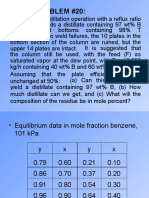0 ratings0% found this document useful (0 votes)
201 viewsAssignment 3
This document contains two questions regarding distillation column problems. Question 1 involves a distillation column separating a 50 mol% benzene/toluene mixture, and calculates various parameters like minimum reflux ratio, bottoms composition, and moles of product per 100 moles of feed for different feed types and operating conditions. Question 2 involves a distillation column separating a 54.5 mol% benzene/chlorobenzene mixture, and asks to calculate the expected product and bottoms compositions given specifications of the partial reboiler, total condenser, and reflux ratio.
Uploaded by
Zakareya RamadhanCopyright
© © All Rights Reserved
Available Formats
Download as PDF, TXT or read online on Scribd
0 ratings0% found this document useful (0 votes)
201 viewsAssignment 3
This document contains two questions regarding distillation column problems. Question 1 involves a distillation column separating a 50 mol% benzene/toluene mixture, and calculates various parameters like minimum reflux ratio, bottoms composition, and moles of product per 100 moles of feed for different feed types and operating conditions. Question 2 involves a distillation column separating a 54.5 mol% benzene/chlorobenzene mixture, and asks to calculate the expected product and bottoms compositions given specifications of the partial reboiler, total condenser, and reflux ratio.
Uploaded by
Zakareya RamadhanCopyright
© © All Rights Reserved
Available Formats
Download as PDF, TXT or read online on Scribd
You are on page 1/ 2
Assignment # 3
CHENG 313 : Separation II
Due : 28 March 2013
Q1.
A distillation unit consists of a partial reboiler, a column with seven equilibrium plates,
and a total condenser. The feed consists of a 50 mol % of benzene in toluene. It is desired
to produce a distillate containing of 96 mol % benzene, when operating at 101 kPa.
i. With saturated liquid feed fed to the fifth plate from the top determine:
a. minimum reflux ratio
b. the bottoms composition, using a reflux ratio of twice the
minimum.
c. Moles of product per 100 moles of feed.
ii. Repeat part (i) for a saturated vapor feed fed to the fifth plate from the
top.
iii. With saturated vapor feed fed to the reboiler and a reflux ratio (L/V) of
0.9, calculate
a. Bottoms composition,
b. Moles of product per 100 mole of feed.
Q2.
A mixture of 54.5 mol% benzene in chlorobenzene at its bubble point is fed continuously
to the bottom of a column containing two theoretical plates. The column is equipped with
a partial reboiler and a total condenser. Sufficient heat is supplied to the reboiler to give
V/F= 0.855 and the reflux ratio L/V in the top of the column is kept constant at 0.5.
Under these conditions, what quality of product and bottoms (xD, xB) can be expected.
You might also like
- CHE3044F: Reactor Design 1: TUTORIAL 7, 2012: April 29, 2013No ratings yetCHE3044F: Reactor Design 1: TUTORIAL 7, 2012: April 29, 20132 pages
- MEC551 Test 1 Solution (Sept2011-Feb2012) Student100% (1)MEC551 Test 1 Solution (Sept2011-Feb2012) Student4 pages
- FALLSEM2015-16 CP3149 04-Aug-2015 RM01 Tutorial-1100% (1)FALLSEM2015-16 CP3149 04-Aug-2015 RM01 Tutorial-12 pages
- Assignment On Continuous Distillation - McCabe-Thiele Method (1) - 14425730247850% (1)Assignment On Continuous Distillation - McCabe-Thiele Method (1) - 14425730247855 pages
- Jan18 CDB2013 - Separation Process I PDFNo ratings yetJan18 CDB2013 - Separation Process I PDF6 pages
- Separation Processes - I (CHE F244) Total Marks - 15 Due Date & Time: 01/07/2020, 5:00 PM AssignmentNo ratings yetSeparation Processes - I (CHE F244) Total Marks - 15 Due Date & Time: 01/07/2020, 5:00 PM Assignment4 pages
- Tutorial Solid Liquid Extraction - Leaching 2022No ratings yetTutorial Solid Liquid Extraction - Leaching 202222 pages
- M AZIZ - PMO470S - MultiComp FUG Dist - Example 2-1 (2020)No ratings yetM AZIZ - PMO470S - MultiComp FUG Dist - Example 2-1 (2020)4 pages
- CHE4171: Biochemical Engineering: TUTOTRIAL Solution Guide (WEEK 3 T3)No ratings yetCHE4171: Biochemical Engineering: TUTOTRIAL Solution Guide (WEEK 3 T3)4 pages
- Jawaharlal Nehru Technological University Kakinada: III Year B. Tech. Petrochemical Engineering II SemNo ratings yetJawaharlal Nehru Technological University Kakinada: III Year B. Tech. Petrochemical Engineering II Sem37 pages
- Absorption Lecture Note - DR Akinsiku PDFNo ratings yetAbsorption Lecture Note - DR Akinsiku PDF7 pages
- Mass Transfer-2 (CLL-352) Tutorial #1: P1) Ammonia (A) Diffuses Through A Stagnant Layer of Air (B), 1cmNo ratings yetMass Transfer-2 (CLL-352) Tutorial #1: P1) Ammonia (A) Diffuses Through A Stagnant Layer of Air (B), 1cm1 page
- Tutorial Solid Liquid Extraction - Leaching 2019No ratings yetTutorial Solid Liquid Extraction - Leaching 20199 pages
- Introductory Applications of Partial Differential Equations: With Emphasis on Wave Propagation and DiffusionFrom EverandIntroductory Applications of Partial Differential Equations: With Emphasis on Wave Propagation and DiffusionNo ratings yet



























































